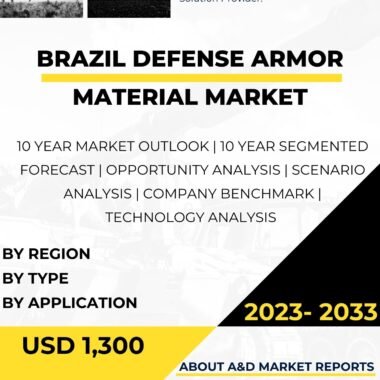Description
The Australia Composites (Defense) Market is a vital and rapidly expanding sector that plays a pivotal role in enhancing the country’s defense capabilities and supporting its military operations. Composites, also known as composite materials, are engineered materials made by combining two or more constituent materials to create a high-performance and lightweight material with specific properties tailored for defense applications. As a nation with vast and diverse defense requirements, Australia recognizes the strategic importance of investing in advanced composite technologies to improve the performance and efficiency of its defense systems. This article provides a comprehensive analysis of the Australia Composites (Defense) Market, covering its current state, key drivers, challenges, applications, technological advancements, and growth prospects.
The Australia Composites (Defense) Market has witnessed significant growth and interest due to the ADF’s focus on modernizing its defense capabilities and adopting new technologies to gain a competitive edge in modern warfare. Composites offer several advantages in defense applications, including high strength-to-weight ratio, excellent durability, resistance to corrosion and fatigue, and the ability to be tailored for specific purposes. These characteristics make composites ideal for various military platforms, including aircraft, naval vessels, ground vehicles, and protective gear.
One of the key drivers behind the market’s prominence is the increasing demand for lightweight and high-performance materials to enhance the mobility and agility of defense systems. Composites enable the development of lightweight structures that improve fuel efficiency and extend the operational range of military aircraft and vehicles. Moreover, the reduced weight allows for increased payload capacity, enabling the integration of more advanced sensors, weapons, and communication systems.
Moreover, the Australia Composites (Defense) Market is driven by the country’s interest in fostering indigenous defense production and technology development. Collaborations between the government, defense industries, and research institutions have led to the development of advanced composites tailored to meet Australia’s specific defense requirements. This approach not only strengthens the country’s defense capabilities but also supports the growth of the local defense industry, creates jobs, and fosters technology export.
The market’s growth is also influenced by Australia’s strategic interests and commitment to regional security. As a nation with extensive maritime territories and responsibilities, composites play a crucial role in enhancing the performance and efficiency of naval vessels and submarines. Additionally, the use of composites in aerospace applications allows the ADF to maintain air superiority and respond rapidly to potential threats in the region.
The Australia Composites (Defense) Market encompasses a wide range of applications and capabilities tailored to meet the diverse needs of the ADF. Composites are used in various defense platforms, including military aircraft, naval vessels, ground vehicles, body armor, helmets, and missile components.
In military aircraft, composites are extensively used in structural components such as wings, fuselage, and empennage, as well as in interior fittings and cabin amenities. The use of composites in aircraft construction results in reduced weight, increased fuel efficiency, and improved stealth characteristics, contributing to enhanced operational capabilities.
For naval vessels, composites find applications in the construction of hulls, decks, masts, and other structural elements. The use of composites in naval vessels enhances their resistance to corrosion and reduces maintenance requirements, leading to improved operational readiness and longevity.
Composites are also utilized in ground vehicles, including armored personnel carriers, tanks, and infantry fighting vehicles. The integration of composites in ground vehicles enhances their survivability, mobility, and protection against ballistic threats, contributing to the safety of the ADF’s troops.
Beyond vehicle platforms, composites play a crucial role in personal protective equipment, such as body armor, helmets, and shields. The use of composites in protective gear provides enhanced protection for military personnel, reducing the risk of injury and increasing their operational effectiveness.
Despite the market’s growth and potential, the Australia Composites (Defense) Market also faces certain challenges. One significant challenge is the need for continuous research and development to stay at the forefront of composite technology and counter emerging threats. As adversaries develop new tactics and technologies, ongoing investment in innovation and technology development is crucial to maintaining a competitive advantage and ensuring the effectiveness of composites in defense applications.
Moreover, addressing the issue of resource allocation and budget constraints is essential for optimizing the procurement and modernization of composites capabilities. Striking a balance between investing in advanced composite technologies and other defense priorities requires careful planning and prioritization.
Additionally, ensuring the security and reliability of composite materials and components is of paramount importance, given the critical nature of these materials in defense applications. Robust quality control measures and testing procedures are necessary to ensure the integrity and performance of composite materials under various operating conditions.
Looking ahead, the Australia Composites (Defense) Market is expected to witness continued growth and advancements. As the ADF continues to modernize its defense capabilities, enhance its operational efficiency, and respond to emerging security challenges, the demand for advanced composite materials will remain strong. Continued investment in research and development, collaboration between the government and industry stakeholders, and a focus on addressing technical challenges will drive advancements in composite technology and applications.
In conclusion, the Australia Composites (Defense) Market is a strategically important sector that supports the country’s defense capabilities and contributes to its military readiness and operational effectiveness. Composites offer unique advantages in terms of lightweight, strength, and customization, making them ideal for various defense platforms and applications. The market’s growth is driven by Australia’s commitment to defense modernization, fostering innovation within its defense industry, and leveraging advanced materials to gain a competitive edge in modern warfare. Addressing challenges related to technology development, resource allocation, and security will be key to unlocking the full potential of the Australia Composites (Defense) Market and supporting the country’s defense and security objectives.




